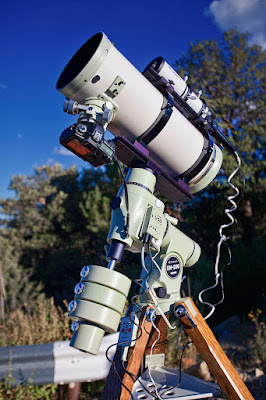Sunday, October 9, 2011
Of Telescopes, Astronomers, and Comets
I repeatly wonder why I practice photography - especially astrophotography. It requires lots of equipment, time and effort. On Friday I had an engineering run on the 2.3 Meter Bok telescope on Kitt Peak. The moon was nearly full and didn't set until nearly 1.5 hours before morning twilight - leaving precious little time under dark skies. Knowing I was going to finish working on the BOk Telescope long before sunrise, I decided to bring my trusty Takahashi Astrograph and mount and attempt to photograph the early morning comet - 45P Honda-Mrkos-Pajdusakova. This periodic comet made a close pass to Earth earlier this year but was poorly placed for northern hemisphere observers. Now close to the sun in the early morning sky - photographing it was going to be a challenge. Though it is sporting a modest tail, it is buried in the morning zodical light and only achieves 12 degrees above the horizon before the onset of morning twilight. To make matters worse - from Kitt Peak I would have to shoot through the heavy glow of the city lights of Tucson. Sigh.
After finishing my duties with the 2.3 Meter Beast - I returned to the dorm around midnight and setup my mount and scope in the parking lot favored by a good eastern horizon and shielded from the wind by low trees.
At about 2:30am as the moon was about to set I decided to attempt a few minutes of imaging on the old standby - M42 - the Orion Nebula. Yeah - I know - everybody shoots this thing - its like a flower for the terrestrial photographer - pedestrian, but pretty. After about an hour of fighting a bad USB extension cable for the autoguider I finally was able to get about 30 minutes of integration with the 5D II on the neb - here is the result.
At 4:15 the comet was supposedly about 5 degrees above the eastern horizon. Not visible with the naked eye (and not having my binoculars) I was forced to search for it using the autoguider. My mount is not a "Goto" model and I had to fall back on my skills I learned as a lowly amateur and star hop to the expected location. After about 5 minutes I found a fuzzy "star" in the guider that was near the predicted postition. Without the luxury of time to decide on whether or not this was the comet - I started taking 1 minute long subframes of the field. 40 minutes later, twilight stopped further efforts on the comet. After inspecting the images - indeed the comet was there - though buried in the fog of the city and zodical glow. After processing - 40+ images revealed the object below.
After a few hours of shut-eye in the dorm I wandered back to the 2.3 Meter dome and finished working on a couple of hardware issues with the spare control system computer. This evening was the annual Tohono O' odham visit to their sacred mountain. All the Observatories were open to the public and the o'odham nation for inspection. The Tucson Amateur Astronomers association (TAAA) were on hand to show visitors views of the moon and celestial objects through various small telescopes (small compared to the monsters that permanently inhabit the mountain). My friends Dean and Melinda Ketelsen are members of the TAAA as well as docents for Kitt Peak. Seeing a note on FB from Mel that they planned on being on the mountain - I made the trek across the hill to where the TAAA had setup teles. It was good to see a couple of fellow astro-nuts and chat briefly with them before having to return to tour duty at the 2.3 Meter. Here are a couple of snaps of the K's setup near the 0.9 Meter that evening.
Labels:
astronomer. portrait,
astrophotography,
Canon 5D,
kitt peak,
KPNO,
m42,
observatory,
TAAA,
Tak E160,
takahashi,
Takahashi E160
Subscribe to:
Post Comments (Atom)








2 comments:
Awesome, Dave, totally awesome. Makes me think about heading back up to KP. Then I wake up...
I have to admit, Brat, that is the most beautiful picture of the old standby (Orion Neb) I have ever seen. Beyond that, I wish I had put on some lipstick.
Post a Comment